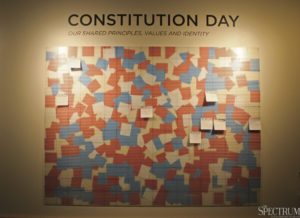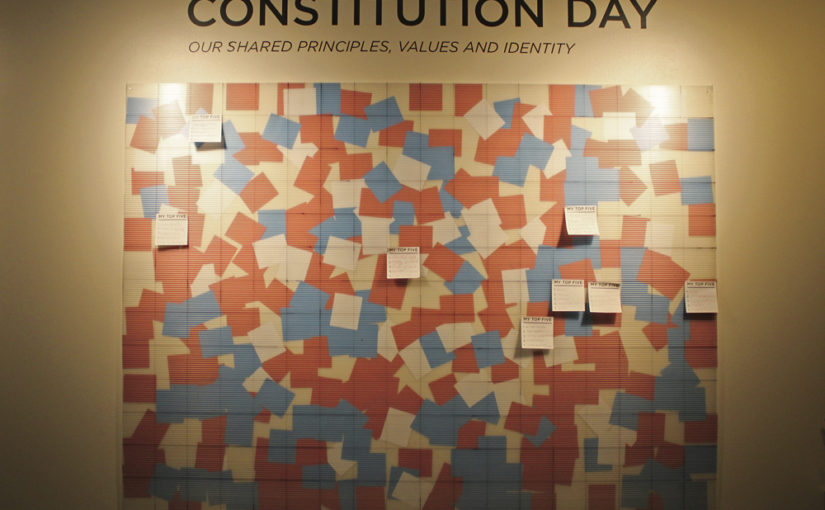
As part of Constitution Day, Civic Engagement Programs created an interactive exhibit that asked students to post their top five values and principles.
“We the people of the United States, in order to form a more perfect union, establish justice, insure domestic tranquility, provide for the common defense, promote the general welfare, and secure the blessings of liberty to ourselves and our posterity, do ordain and establish this constitution for the United States of America.”
These words adorn posters in classrooms, patriotic memorabilia and are carved into monuments across the United States. They are the first words of our constitution, signed in a righteous flurry by the Founding Fathers. But rarely do we think about these words, or even the Constitution, outside of the Fourth of July or President’s Day.
On Tuesday, Sept. 17, the United States celebrated Constitution Day, a day centered around recognizing the Constitution and its ideals.
Each year, Civic Engagement Programs through the Student Activities Office recognizes Constitution Day through various programs and exhibits. This year, graduate assistant Tayler Morris teamed up with the Memorial Union Gallery to design an interactive project meant to spark thought and discussion about our Constitution, and the ideals and principles outlined in it.
“I think in the United States, we take democracy for granted a lot,” Morris said. “And the different rights and principles we have. Not for everyone, I don’t think everyone takes it for advantage. But I think about taking the citizenship test, and I know I probably couldn’t pass a citizenship test, and we expect immigrants to come in and pass and know that information. I think it’s easy to take for granted things we don’t think about every day.”
The idea for this year’s interactive exhibit started last year by Hailey Goplen, the former assistant director for Civic Engagement. Goplen began working with Anthony Faris, the MU Gallery curator and coordinator. After Goplen left for Oregon to pursue teaching, she handed the project off to Morris.
“I reached out to (Anthony Faris) maybe the first or second week I was here, knowing that (Goplen) had already reached out to him,” Morris said. “I went into this meeting with him and his grad student, Yeseul (Lee), and a couple other workers at the gallery. Anthony actually had a better idea of what him and Haley had discussed.”
She continued, “At first, we talked about doing an interactive display of the United States and people would have to try to place states where they belong or know facts about the different states. The brainstorming process was super long and complex, and we had all these different ideas, but we ended up doing something more with democracy in the United States. That’s kind of how we landed on the project we’re doing now.”
The project spans three weeks, starting the Friday before Constitution Day. For week one, students were asked to write their top five values or principles and place it on a board hung by the Student Activities office.
“The idea behind it was we hold these truths to be self-evident,” Morris explained. “For democracy in the United States, or what they believe are the self-evident truths that they live by, that kind of thing.”
In week two, the most common values, principles or themes will be chosen and cut down to 10 or 15. They will then be reconfigured into visual icons that represent. For example, Morris described, “If one of the values is family, maybe there’s a picture of a family and it will still say ‘family.'”
Students will vote on their top five icons, what they think are the most important values and principles.
In the final week, week three, the top ten icons will be chosen and placed on a wheel. The icons will either be red or blue. When students spin the wheel, they may land on a red or blue tile. One will ask students to think about the value they landed on, and how they use it in their daily life. The other will ask students to actively try to use that value or principle throughout the day.
“My hope is that it’ll get students, and faculty and staff as well, to just think about democracy and actively engage with it,” said Morris. “Because I think it’s easy to — I use freedom of speech everyday, but do I think about it as freedom of speech? No. I’m just using my voice to communicate and not everyone has that. I’m hoping that students are more aware of the rights and privileges we have, and what democracy means to them, not only what it means to our country but what it means for them.”
The project is currently on display just outside the Student Activities office.
For more information on Civic Engagement Programs, visit their page through the NDSU website.
